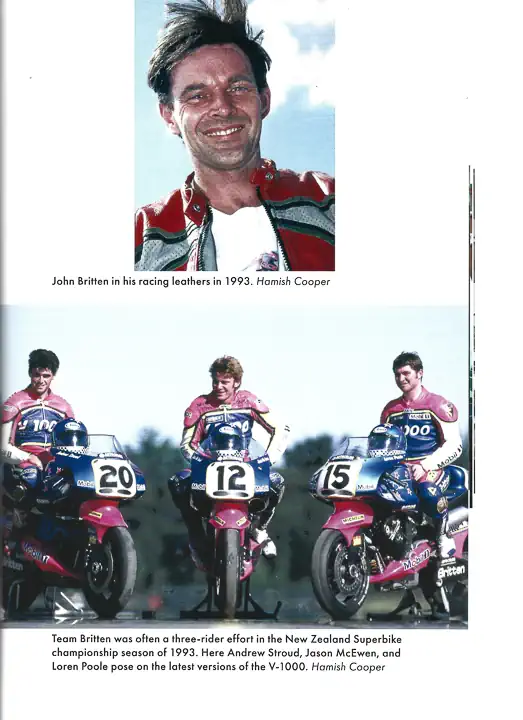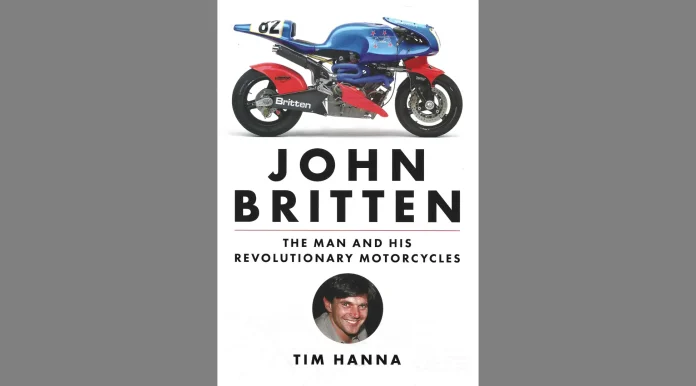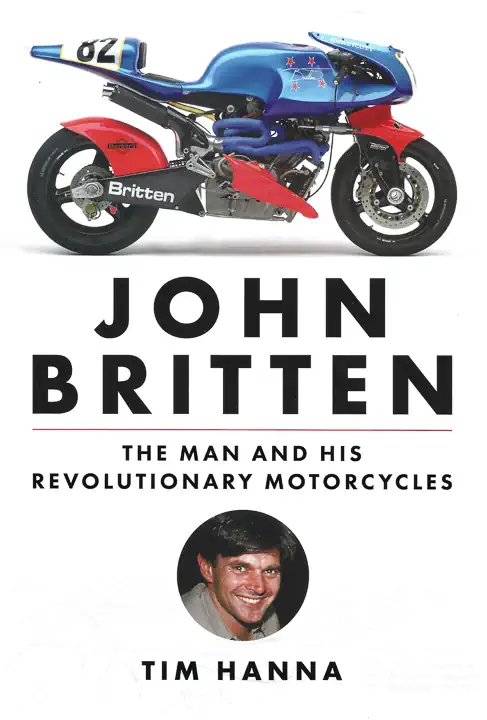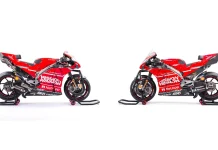If you remember John Britten as a maverick genius motorcycle designer/builder who took on the major motorcycle manufacturers in Battle of the Twins, Pro Twins, and Formula One road racing back in the 1990s, you know the headline part of the Britten story.
In John Britten: The Man and His Revolutionary Motorcycles, just re-released by Octane Press, author Tim Hanna reveals there was so much more to Britten and his stunning, race-winning motorcycles. Britten’s personality and interests were as complex as his technical achievements.
Hanna reveals who Britten was from his earliest days, along with many insights about Britten’s family and its four-generation history in New Zealand. Indeed, the Britten family’s success in business was a factor in a young John Britten having some financial freedom to pursue a variety of interests, which, it turns out, were many. Hanna weaves how those early pursuits, which included manufacturing leaded stained-glass lamps, real estate, and architecture, among other things, contributed to Britten’s ability to recognize and recruit individuals with the kind of skills to eventually join his efforts to create ground-breaking racing motorcycles.
Britten was a motorcyclist in his youth and a successful club racer in his own right. Indeed, he was involved in promoting motorcycle racing in New Zealand as a co-founder of British, European, and American Racing Class (BEARS) in 1983. BEARS was created for non-Japanese motorcycles to facilitate competition among bike brands that simply could not keep up with Japanese sport bikes at the time.

Hanna relates the first efforts of Britten’s tiny race team at Ruapuna Raceway on the South Island of New Zealand in January 1989. It was among the first appearances of a Britten-designed race bike on any track. It was only a practice day, but it didn’t go well.
Out on the track the machine circulated erratically, as the engine spat and popped, while a plastic hose poking out the back of the bodywork dribbled a steady stream of oil from the crankcase. For the rest of the afternoon the group fiddled with its innards between hesitant laps, tweaking the fuel-injection system in a vain attempt to find smooth running and power.
Hanna chronicles the development of the Britten racing motorcycles in remarkable detail, thanks to his extensive research and interviews with Britten team members.
The road—or, perhaps more accurately stated, the track—to the later Britten V1000 and V1100 racers that captured the world’s imagination and the attention of everyone in the motorcycle industry was fraught with problems. In many instances, the issues arose from relatively minor component problems. As an example, early on, a major stumbling block was getting the electronic fuel injection system to work consistently and to survive the rigors of the racing environment.
Hanna tells the story from the Denco-powered Aero D Zero and Aero D One in 1987-1988 to the successes of the V1000 with its bespoke Britten V-twin engine. The story includes the lesser-known story of the land speed record efforts that saw the Britten machine make appearances at Bonneville Salt Flats.

In a departure from most of the Britten motorcycle story, the land speed record effort was not the brainchild of John Britten himself, but rather, of Jon White, another New Zealand racer. Although Britten initially was not enthused about the project, he eventually came to support it.
White’s first attempt to capture the New Zealand speed record in November 1993, set on a closed public road, ended in a crash on the return run at about 120 mph. White suffered an injury to a finger, and damage to the bike was minimal, but no additional attempt was made that day.
After the switch to the use of a dustbin fairing, which enclosed the front wheel, a subsequent attempt did give the result White was looking for—a New Zealand record for the flying mile at 188.092 mph. At first, it appeared an FIM world record had not been achieved, but later, it became clear that it had. The next effort would be in the States at Bonneville.

The team’s experience at Speed Week was frustrated by a crash during an early run, which damaged the oil cooler and tail section. After the cooler was repaired, subsequent runs had handling problems that kept the bike from getting beyond its best run of 187 mph—far short of the record speed required. After that, Britten’s focus shifted away from land speed records and to the 1994 Daytona Pro Twins race in March and the Isle of Man TT in June.
Hanna documents the impressions of Britten’s friends and teammates that noticeable changes in his attitudes, behavior, and health were beginning to show in the early 1990s. At the time, it would have been easy to dismiss the occasional changes as stress-related because Britten had so many irons in the fire.
Britten’s spirits rose, and his sense of humor returned with Andrew Stroud’s victory in the Daytona Pro Twins race. However, as Hanna documents, the object of Britten’s true obsession was a victory in the Isle of Man TT. To achieve that, Britten planned a maximum effort, with three Britten machines making the odyssey to the island.
Tragedy struck when Mark Farmer was fatally injured during practice on the Mountain Course. Post-crash review attributed the incident to rider error, not mechanical failure. Britten himself was devastated and initially wanted to withdraw the bikes, but he was convinced to see the race through.
A second blow to the Britten team came when Jason McEwen was informed at the start line for the Formula One event that he would not be allowed to compete, reducing the Britten effort to one remaining bike, ridden by Nick Jeffries. That Britten machine conked out in the Formula One event with a rain-soaked misfiring ignition, and dropped out of the Senior TT with a transmission failure.
Britten began to experience more fatigue and appeared drawn and weaker in the months that followed. Finally, he was given a thorough medical work-up. Cancer that had metastasized to his liver was found. The prognosis was grim, with his life expectancy only a few months. On September 5, 1995, John Britten died at the age of 45, survived by his wife, Kirsteen, and three children.
In a fitting tribute to Britten and his dream, Loren Poole rode a Britten to the 1995-96 New Zealand Superbike Championship, and other Britten bikes claimed victories around the world to the cusp of the 21st century.
By the last page of Hanna’s remarkable book, you’ll feel like you knew John Britten and were on hand to witness his varied achievements and setbacks. Most of all, you’ll have been taken inside Britten Motorcycles’ history and can separate the headline legend from the real story.
John Britten: The Man and His Revolutionary Motorcycles Fast Facts
- Title: John Britten: The Man and His Revolutionary Motorcycles
- Author: Tim Hanna
- Published: Octane Press, 2025; original published in 2003 by Craig Potton Publishing
- Publisher: Octane Press
- Format: hardcover, 498 pages, 43 color images.
- ISBN: 978-1-64234-130-0
John Britten: The Man and His Revolutionary Motorcycles Price: $47 MSRP








